 Firenze.: an almost lovely city infested by tourism. Handsome Renaissance buildings and medieval streets, endless Madonnas and baby Christs. Many residents (native or immigrants) and the city government thrive on taking advantage of the tourists, which leaves a sour taste sometimes. The tourist information booth at the train station sells the free tourist map for €1. Cover charge + service charge in restaurants, €4 reservation fee for museums, hefty fines every time you pass into "Zona Traffico Limitato". Peddlers in the market who cheat ... Except for my little hotel, who went out of the way to help their customers. The grandpa cut a plug and used duct tape to make me a temporary outlet converter.
Firenze.: an almost lovely city infested by tourism. Handsome Renaissance buildings and medieval streets, endless Madonnas and baby Christs. Many residents (native or immigrants) and the city government thrive on taking advantage of the tourists, which leaves a sour taste sometimes. The tourist information booth at the train station sells the free tourist map for €1. Cover charge + service charge in restaurants, €4 reservation fee for museums, hefty fines every time you pass into "Zona Traffico Limitato". Peddlers in the market who cheat ... Except for my little hotel, who went out of the way to help their customers. The grandpa cut a plug and used duct tape to make me a temporary outlet converter. No lines. Home to the Medicis for ~200 years. Imposing yet austere facade. Expansive Boboli garden lined with statues and fountains. Each room of the Palatine Gallery and Royal Apartments has information brochures in either Italian and English, describing the function of the room and every object in the room, with more notable pieces listed in red. The Palatine Gallery is not to be missed. Lavishly decorated by Pietro da Cortona. It was to inspired Le Brun for Vaux-le-Vicomte and later Versailles, long before it was finished. Each room has a theme denoted by its ceiling fresco. Every wall is stacked with paintings from the ceiling to the floor, including the top of the doorways, arranged to the taste of its former user, with no particular order. 11 by Raphael and 10 by Titian, arguably their best, 16 Andrea del Sarto, 4 Tintoretto, 6 Rubens, 2 Vandyke, 2 Murillo, 2 ugly Botticelli. Roman statues, French vases and clocks. Better and larger collection than Uffizi, in my opinion. I especially like those marble tables with intricate precious stone inlay tops. The Royal Apartments are more recent, equally Sumptuous, more velvet than paintings. The Modern Art Gallery on the top floor is not to be ignored. 30 Baroque rooms exhibits 19th to early 20th century Italian paintings. For example: 60+ Fattori (temporary?), Ussi, Nomellini.
No lines. Home to the Medicis for ~200 years. Imposing yet austere facade. Expansive Boboli garden lined with statues and fountains. Each room of the Palatine Gallery and Royal Apartments has information brochures in either Italian and English, describing the function of the room and every object in the room, with more notable pieces listed in red. The Palatine Gallery is not to be missed. Lavishly decorated by Pietro da Cortona. It was to inspired Le Brun for Vaux-le-Vicomte and later Versailles, long before it was finished. Each room has a theme denoted by its ceiling fresco. Every wall is stacked with paintings from the ceiling to the floor, including the top of the doorways, arranged to the taste of its former user, with no particular order. 11 by Raphael and 10 by Titian, arguably their best, 16 Andrea del Sarto, 4 Tintoretto, 6 Rubens, 2 Vandyke, 2 Murillo, 2 ugly Botticelli. Roman statues, French vases and clocks. Better and larger collection than Uffizi, in my opinion. I especially like those marble tables with intricate precious stone inlay tops. The Royal Apartments are more recent, equally Sumptuous, more velvet than paintings. The Modern Art Gallery on the top floor is not to be ignored. 30 Baroque rooms exhibits 19th to early 20th century Italian paintings. For example: 60+ Fattori (temporary?), Ussi, Nomellini. 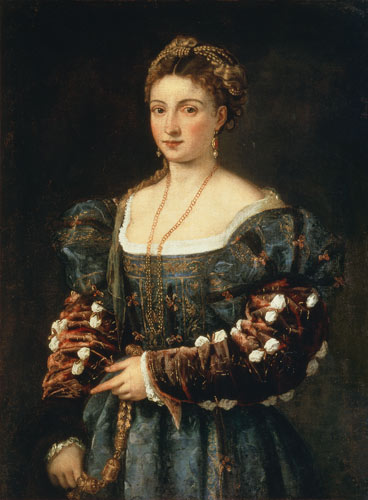   |
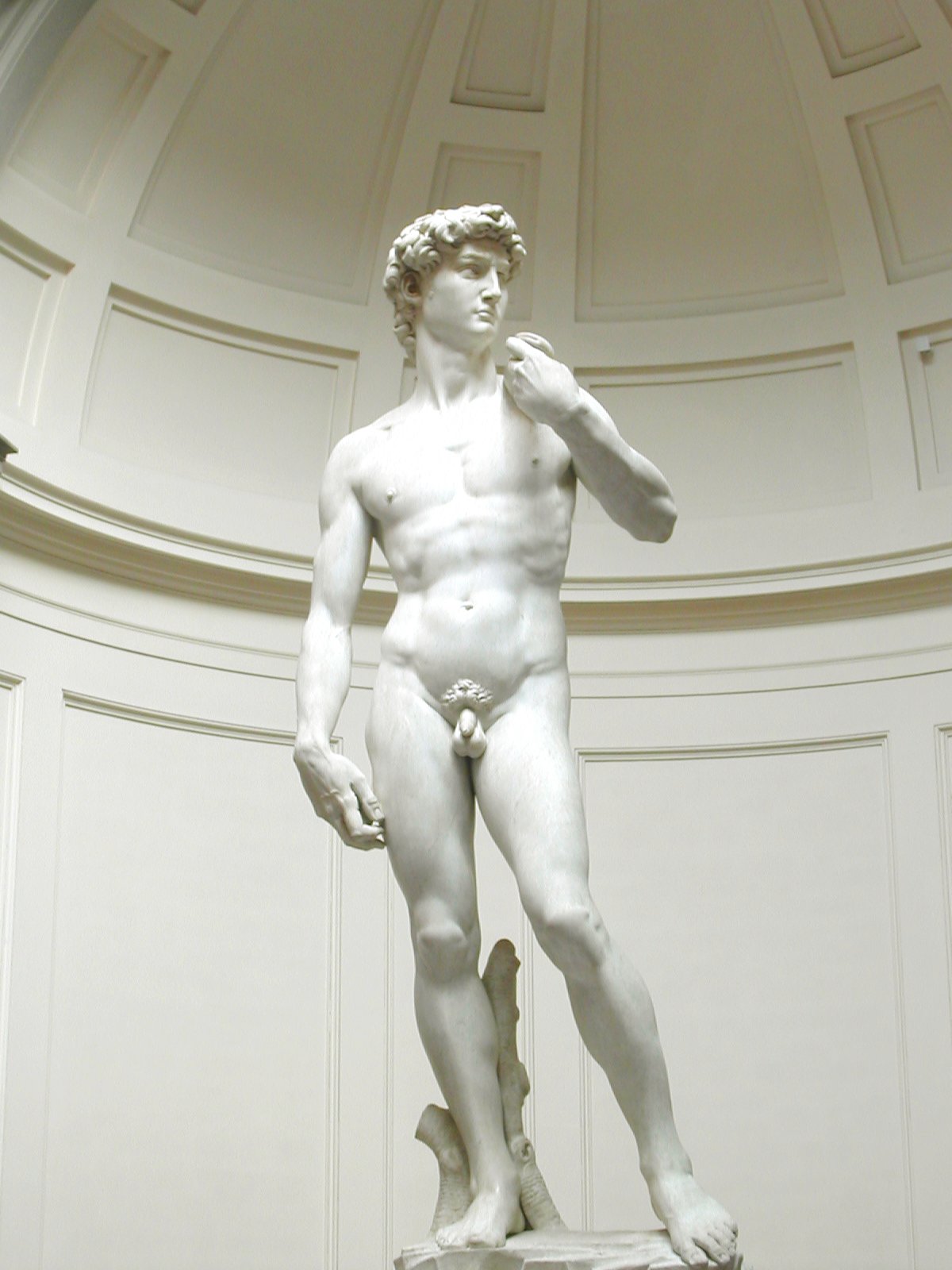 Art Academy Gallery (€6.5) has a short line. It houses prize winning/attempting submissions and clay models by art students throughout the years, along with a few by more well known giants (e.g. 2 Madonnas by Botticelli). David is impressive (watch the vein on the back of his hands). After nearly 400 years of weathering, David is cleverly displayed under a dome, like on an altar, at the end of a corridor lined with unfinished sculptures by Michelangelo. Interesting to see how forms emerge from a cold block of marble. There's a computer screen to show every angle of David. A small room at a corner exhibits some music instruments collected by the Medicis + two small models showing how harpsichord and piano work. Walking upstairs, you'd see a collection of Russian icons on the wall. Upper floor exhibits boring medieval Jesus paintings on wooden panels collected from various churches. A girl explains how egg tempera was applied in those days - that's quite informative.
Art Academy Gallery (€6.5) has a short line. It houses prize winning/attempting submissions and clay models by art students throughout the years, along with a few by more well known giants (e.g. 2 Madonnas by Botticelli). David is impressive (watch the vein on the back of his hands). After nearly 400 years of weathering, David is cleverly displayed under a dome, like on an altar, at the end of a corridor lined with unfinished sculptures by Michelangelo. Interesting to see how forms emerge from a cold block of marble. There's a computer screen to show every angle of David. A small room at a corner exhibits some music instruments collected by the Medicis + two small models showing how harpsichord and piano work. Walking upstairs, you'd see a collection of Russian icons on the wall. Upper floor exhibits boring medieval Jesus paintings on wooden panels collected from various churches. A girl explains how egg tempera was applied in those days - that's quite informative. Uffizi (€6.5) is so hyped up that the lines could be 3+ hrs.
Uffizi (€6.5) is so hyped up that the lines could be 3+ hrs.  Even with advanced timed reservation, there was a line. By showing up at the door at 7:45am, I was able to get in by 8:30am sans reservation. The best of this museum is the view over Arno and its bridges. A small collection (2nd floor only), most notably for Botticelli's Venus in the half shell and Spring, Titian's Venus of Urbino, a couple of Caravaggio's, 3 so-so Raphael's, 2 bad Da Vinci's, and a rare non-fresco painting by Michelangelo: Doni Tondo. Botticelli is the biggest draw, but his paintings lack proper 3D and rich color, unlike the late comers. Outside, in the U shape courtyard is the "hall of fame": statues of Lorenzo the Magnificent, Giotto, Donatello, Alberti, da Vinci, Michelangelo, Dante, Petrarch, Boccaccio, Machiavelli, Vespucci, Galileo.
Even with advanced timed reservation, there was a line. By showing up at the door at 7:45am, I was able to get in by 8:30am sans reservation. The best of this museum is the view over Arno and its bridges. A small collection (2nd floor only), most notably for Botticelli's Venus in the half shell and Spring, Titian's Venus of Urbino, a couple of Caravaggio's, 3 so-so Raphael's, 2 bad Da Vinci's, and a rare non-fresco painting by Michelangelo: Doni Tondo. Botticelli is the biggest draw, but his paintings lack proper 3D and rich color, unlike the late comers. Outside, in the U shape courtyard is the "hall of fame": statues of Lorenzo the Magnificent, Giotto, Donatello, Alberti, da Vinci, Michelangelo, Dante, Petrarch, Boccaccio, Machiavelli, Vespucci, Galileo. 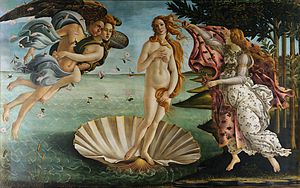 | |
 | 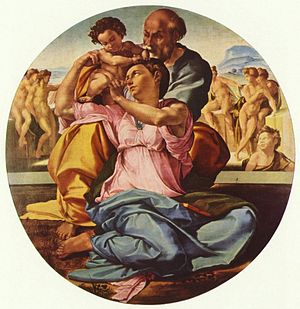 |
 North of Uffizi is Piazza della Signroia, the center. Lively, overwatched by Plazzo Vecchio (the powerhouse). A lovely loggia at the end of Uffizi was once the public forum, now stands some large worthy sculptures. A plaque on the ground a few steps in front of to the Fountain of Neptune commemorates where Savonarola was defrocked and burned.
North of Uffizi is Piazza della Signroia, the center. Lively, overwatched by Plazzo Vecchio (the powerhouse). A lovely loggia at the end of Uffizi was once the public forum, now stands some large worthy sculptures. A plaque on the ground a few steps in front of to the Fountain of Neptune commemorates where Savonarola was defrocked and burned.South of Uffizi passing Vasari Corridor is Ponte Vecchio, a famous bridge lined up with jewelry shops.
 Bargello is a small sculpture museum. Quite boring. The building has more character: a former barrack and police station, built in 13thcentury. A Donatello room, including the competition entries by Ghiberti and Brunelleschi for the Baptistery Door, side by side. A slightly larger room a few bigger sculptures including 3 by Michelangelo. 2nd floor is dinnerware, so-so jewelry, and colorful terracotta panels of Mary and baby. 3rd floor is armory.
Bargello is a small sculpture museum. Quite boring. The building has more character: a former barrack and police station, built in 13thcentury. A Donatello room, including the competition entries by Ghiberti and Brunelleschi for the Baptistery Door, side by side. A slightly larger room a few bigger sculptures including 3 by Michelangelo. 2nd floor is dinnerware, so-so jewelry, and colorful terracotta panels of Mary and baby. 3rd floor is armory.Other civic places one can visit are Science History Museum, Michelangelo's House, Palazzo Davanzati (free), Palazzo Strozzi (now host temporary exhibitions on two different floors), Palazzo Medici-Riccardi, Piazza della Repubblica (site of original Roman Forum). The iron-glass central market (closed at 2pm, and on Sundays) near the train station, and the flea-like market around San Lorenzo (Medici's burial place), selling South American leathers and other tourist trinkets.
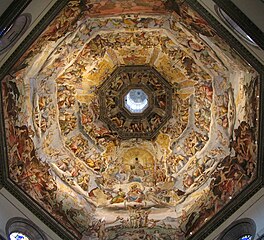 Duomo, built in 1296-1436, is impressive, but only the outside. The Duomo complex also includes Giotto's elegant Campanile 1435, and Baptistery 1059 - 1128 (notable for its magnificent mosaic ceiling and the 12 bronze panels on the door, 3 of which was exhibited in Seattle Art Museum less than a year ago). Rather empty inside except for the giant painting (1572-9) on the dome ceiling, which you can only see if you walk to the top of the Brunelleschi's dome (€8, quite a line, closed on Sundays), so you must.
Duomo, built in 1296-1436, is impressive, but only the outside. The Duomo complex also includes Giotto's elegant Campanile 1435, and Baptistery 1059 - 1128 (notable for its magnificent mosaic ceiling and the 12 bronze panels on the door, 3 of which was exhibited in Seattle Art Museum less than a year ago). Rather empty inside except for the giant painting (1572-9) on the dome ceiling, which you can only see if you walk to the top of the Brunelleschi's dome (€8, quite a line, closed on Sundays), so you must. Santa Croce (€5, closed Sunday till 13:00, can enter from the leather school at the left end for free) holds tombs of Michelangelo, Galileo, Machiavelli, Ghiberti, Rossini among many others. A statue of liberty stands by the door, breaking her chain (tomb of Giovanni Basttista Niccolini).
Santa Croce (€5, closed Sunday till 13:00, can enter from the leather school at the left end for free) holds tombs of Michelangelo, Galileo, Machiavelli, Ghiberti, Rossini among many others. A statue of liberty stands by the door, breaking her chain (tomb of Giovanni Basttista Niccolini).  A rumpled part of St. Francis' tunic and a Papal Bull that legitimized Franciscan are displayed in a glass case along the right wall in the sacristy at the right end. A Donatello bronze, fabulous stain glass windows, many impressive frescoes (including the entire far end wall of the refectory: Tree of the Cross by Gaddi), a status of liberty. The elegant Pazzi Chapel and cloister was by Brunelleschi.
A rumpled part of St. Francis' tunic and a Papal Bull that legitimized Franciscan are displayed in a glass case along the right wall in the sacristy at the right end. A Donatello bronze, fabulous stain glass windows, many impressive frescoes (including the entire far end wall of the refectory: Tree of the Cross by Gaddi), a status of liberty. The elegant Pazzi Chapel and cloister was by Brunelleschi. San Marco (€4) merits a quick visit, home to the religious lives of Fra Angelico, Savonarola, Fra Bartolomeo, and Cosimo de Medici when in a retreat mood. Monks lived on the upper floor. Fra Angelico painted its many walls including ~half of the cells. The end of this corridor in the left picture is Savonarola's cell. Extremely simple, 3 tiny rooms feels more like caves.
San Marco (€4) merits a quick visit, home to the religious lives of Fra Angelico, Savonarola, Fra Bartolomeo, and Cosimo de Medici when in a retreat mood. Monks lived on the upper floor. Fra Angelico painted its many walls including ~half of the cells. The end of this corridor in the left picture is Savonarola's cell. Extremely simple, 3 tiny rooms feels more like caves.My favorite church is San Miniato al Monte. Free. Situated on the top of the hill south of Arno. View of Florence is fantastic. Mosaic altar ceiling. Not a small cemetery. Some of the tombs are elaborate, almost like a reduced Duomo. Many people stop at the large Piazzale Michelangelo centered around a giant David, which offers free parking. Even in this cold afternoon, just after the rain, at least two wedding groups were taking photos.
Orsanmichele. Free. A grain market in the 1300s (was an open loggia, with warehouse upstairs). Interestingly medieval but civil. Statues filled the niches on the outside wall (2 by Donatello), some decorated with sign the guilds who paid for the work.
A short bus (30 mins, every 20 mins) ride takes you to Fiesole, for cooler weather and a grand view of the Arno valley (walk up via San Francesco). Passing by vineyards and former villas, you get to see the dry climate: most vegetation is brushes and trees with small leaves. A sleepy little Etruscan town, hard to imagine its former power which rivaled Florence.